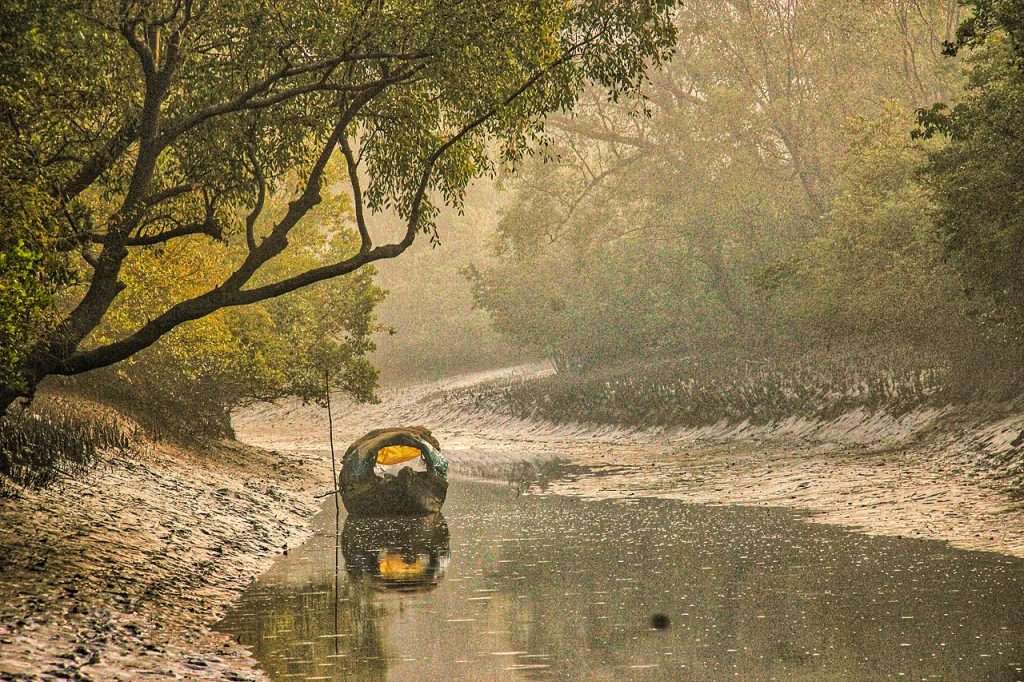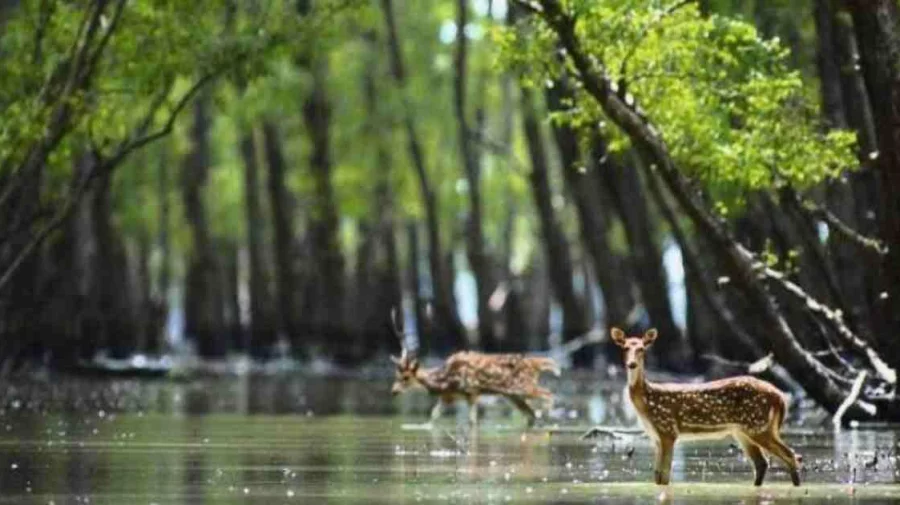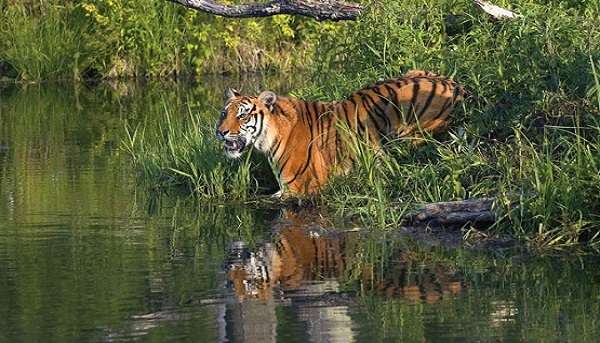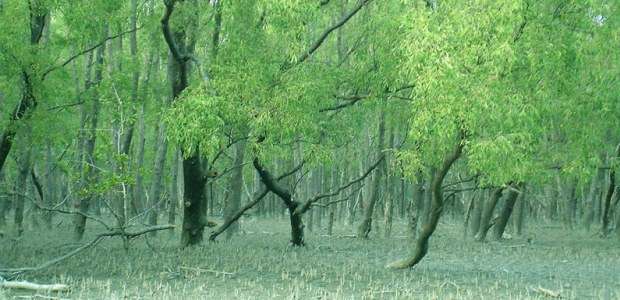
Etymology of Sundarbans
The name “Sundarbans” is derived from the Bengali words “Sundar” (beautiful) and “ban” (forest), aptly describing this vast and stunning mangrove forest. The etymology reflects the natural beauty and significance of this region, which is recognized as the largest tidal halophytic mangrove forest in the world.
History
It’s dates back centuries, with references found in ancient texts and records. Originally inhabited by indigenous tribes, the area has seen significant changes over time, including periods of colonial exploitation and modern conservation efforts. The region’s rich history includes its use by ancient civilizations for wood and honey, as well as its role as a critical habitat for diverse wildlife.
Geography
Located in the delta region of the Padma, Meghna, and Brahmaputra river basins, the Sundarbans spans both Bangladesh and India, covering approximately 10,000 square kilometers. This vast expanse of mangrove forest is interspersed with a complex network of tidal waterways, mudflats, and small islands. The geographical positioning of the Sundarbans makes it a crucial barrier against coastal erosion and storm surges from the Bay of Bengal.
Physiography
The Sundarbans features a unique landscape with dense mangrove forests, tidal waterways, mudflats, and small islands, creating a rich and diverse ecosystem. The physiography of the Sundarbans is characterized by its dynamic interplay between land and water, heavily influenced by the tidal action of the Bay of Bengal. This ever-changing landscape supports a wide array of plant and animal life, making it a vital ecological region.
Ecoregions
Flora
The Sundarbans is renowned for its diverse plant life, including the dominant Sundari (Heritiera fomes) and Gewa (Excoecaria agallocha) trees, which are adapted to the saline conditions of the region. These mangroves play a crucial role in protecting the coastline from erosion, filtering pollutants, and providing habitat for a variety of species. Other significant flora include the Nypa palm, Avicennia, and Rhizophora, which contribute to the forest’s complex and productive ecosystem.
Fauna
The Sundarbans is home to a variety of animal species, making it one of the most biodiverse regions on the planet.

Bengal Tiger
The Sundarbans is famously home to the Bengal tiger (Panthera tigris tigris). These majestic creatures are adapted to the challenging conditions of the mangrove forests, displaying unique behaviors such as swimming across tidal channels. The Bengal tiger is a symbol of the Sundarbans’ wild beauty and its complex ecosystem. Conservation efforts are critical to protect this endangered species from threats such as poaching, habitat loss, and human-wildlife conflict.
Endangered and Extinct Species
Besides the Bengal tiger, the Sundarbans hosts several other endangered species, including the Irrawaddy dolphin, estuarine crocodile, and the Indian python. Conservation measures are in place to protect these vulnerable species, although challenges remain due to habitat degradation, climate change, and illegal hunting. The extinction of species such as the Javan rhinoceros, which once roamed these forests, underscores the urgent need for effective conservation strategies.
Climate Change Impact
Climate change poses a significant threat to the Sundarbans, with rising sea levels and increased salinity jeopardizing both flora and fauna. The frequency of extreme weather events, such as cyclones, has also increased, leading to habitat destruction and displacement of wildlife. These changes threaten the delicate balance of the Sundarbans ecosystem, making conservation and climate adaptation efforts more critical than ever.
Hazards
Natural hazards like cyclones, floods, and tidal surges frequently impact the Sundarbans, causing substantial damage to its delicate ecosystem. Human activities, including deforestation, pollution, and unsustainable resource extraction, further exacerbate these problems. The region’s vulnerability to natural and human-induced hazards highlights the need for comprehensive disaster management and environmental protection strategies.

Economy
The local economy relies heavily on that for resources such as honey, fish, and timber. Traditional occupations like fishing, honey collection, and woodcutting are integral to the livelihoods of the local communities. Eco-tourism is also growing, providing income for local communities while promoting conservation awareness. Sustainable practices are crucial to balance economic needs with environmental protection, ensuring the long-term health of the Sundarbans ecosystem.
Administration
This is in Bangladesh is managed by the Forest Department, which enforces regulations to protect and preserve the area. This includes measures such as patrolling for illegal activities, managing human-wildlife conflict, and implementing conservation programs. International collaborations and conservation programs also play a role in its administration, helping to ensure that the Sundarbans remains a vibrant and vital ecosystem.
Protected Areas
Several parts of the Sundarbans are designated as protected areas, including the Sundarbans Reserve Forest and the Sundarbans National Park. These areas are vital for the conservation of its unique biodiversity and for research on sustainable management practices. Protected areas help to safeguard critical habitats and species, providing a refuge from the pressures of human activity and climate change.
In Popular Culture
The Sundarbans has inspired numerous works of literature, films, and documentaries, highlighting its mystical allure and ecological significance. It remains a symbol of nature’s beauty and resilience in the face of environmental challenges. The region’s depiction in popular culture helps to raise awareness about its conservation and the need to protect this unique environment for future generations.
See Also
- Bengal tiger: Explore the life and conservation efforts of the iconic Bengal tiger in the Sundarbans.
- Mangrove ecosystems: Understand the importance and function of mangrove forests in coastal protection and biodiversity support.
- Climate change adaptation strategies: Learn about the methods and policies implemented to mitigate the impacts of climate change on vulnerable ecosystems like the Sundarbans.
Notes
This article provides an overview of the Sundarbans, emphasizing its natural beauty, ecological importance, and the modern challenges it faces. The focus on the Bengal tiger, mangrove ecosystems, and climate change adaptation strategies highlights the critical issues and efforts needed to preserve this unique and vital region. As we look to the future, integrating AI and modern technology in conservation efforts will be essential to effectively manage and protect the Sundarbans, ensuring that it remains a thriving ecosystem for generations to come.

